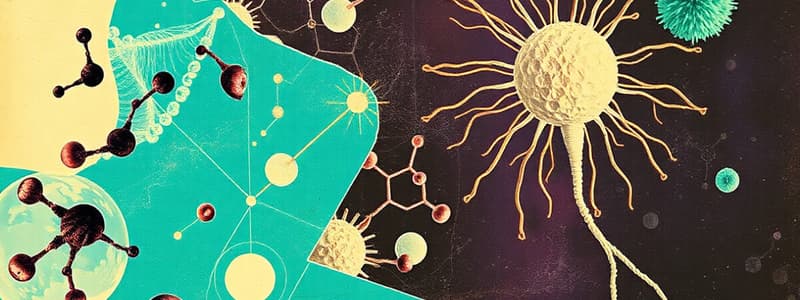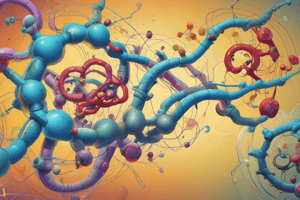Podcast
Questions and Answers
Quel scientifique a isolé pour la première fois les acides nucléiques?
Quel scientifique a isolé pour la première fois les acides nucléiques?
- Gregor Mendel
- Friedrich Miescher (correct)
- Linus Pauling
- James Watson
Quelle loi de Mendel stipule que chaque caractère transmissible est défini par une paire de gènes?
Quelle loi de Mendel stipule que chaque caractère transmissible est défini par une paire de gènes?
- Loi de la Variation Génétique
- Loi de l’Assortissement Indépendant
- Loi de la Dominance
- Loi de la Ségrégation (correct)
Quel événement se produit lors de la métaphase de la mitose?
Quel événement se produit lors de la métaphase de la mitose?
- Alignement des chromosomes à l’équateur (correct)
- Duplication du matériel nucléaire
- Formation de la membrane nucléaire
- Séparation des chromatides vers les pôles
Quel chercheur était reconnu pour avoir proposé une structure d'ADN à trois hélices?
Quel chercheur était reconnu pour avoir proposé une structure d'ADN à trois hélices?
Quel est le rôle déterminant de la séquence d'acides aminés dans les protéines?
Quel est le rôle déterminant de la séquence d'acides aminés dans les protéines?
Quel système tampon a un pKa de 6,8 et est présent à des concentrations milimolaires ?
Quel système tampon a un pKa de 6,8 et est présent à des concentrations milimolaires ?
Quel est le rôle des protéines dans les systèmes biologiques ?
Quel est le rôle des protéines dans les systèmes biologiques ?
Quelles sont les unités structurales de base des protéines ?
Quelles sont les unités structurales de base des protéines ?
Combien d'acides aminés composent généralement une protéine?
Combien d'acides aminés composent généralement une protéine?
Quel acide aminé est connu pour avoir deux formes isomères, L et D ?
Quel acide aminé est connu pour avoir deux formes isomères, L et D ?
Quel est le poids molecular approximatif d'un acide aminé ?
Quel est le poids molecular approximatif d'un acide aminé ?
Quelle fonction remplissent les canaux protéiques dans les membranes cellulaires ?
Quelle fonction remplissent les canaux protéiques dans les membranes cellulaires ?
Quelle structure moléculaire est responsable de la diversité des acides aminés ?
Quelle structure moléculaire est responsable de la diversité des acides aminés ?
Quels types de protéines sont impliqués dans le transport de l'oxygène ?
Quels types de protéines sont impliqués dans le transport de l'oxygène ?
Quel type de sucre est présent dans l'ADN par rapport à l'ARN ?
Quel type de sucre est présent dans l'ADN par rapport à l'ARN ?
Quel est le rôle principal des hélicases dans la réplication de l'ADN ?
Quel est le rôle principal des hélicases dans la réplication de l'ADN ?
Quelle enzyme est responsable de la synthèse d'un brin néosynthétisé lors de la réplication de l'ADN ?
Quelle enzyme est responsable de la synthèse d'un brin néosynthétisé lors de la réplication de l'ADN ?
Quelles sont les conditions nécessaires pour la dénaturation de l'ADN ?
Quelles sont les conditions nécessaires pour la dénaturation de l'ADN ?
Quel type de réplication est effectué chez les procaryotes ?
Quel type de réplication est effectué chez les procaryotes ?
Quel est le taux d'erreurs lors de la réplication de l'ADN ?
Quel est le taux d'erreurs lors de la réplication de l'ADN ?
Quel élément joue un rôle stabilisateur dans la réplication de l'ADN ?
Quel élément joue un rôle stabilisateur dans la réplication de l'ADN ?
Quel est le rôle de la dégradation des ARNm non-sens par NMD ?
Quel est le rôle de la dégradation des ARNm non-sens par NMD ?
Pourquoi la rifampicine n’inhibe-t-elle pas l’élongation de la transcription ?
Pourquoi la rifampicine n’inhibe-t-elle pas l’élongation de la transcription ?
Quel énoncé est vrai concernant les codons STOP ?
Quel énoncé est vrai concernant les codons STOP ?
Comment la dégénérescence du code génétique minimise-t-elle l'effet des mutations ?
Comment la dégénérescence du code génétique minimise-t-elle l'effet des mutations ?
Quel type de mutation provoque un changement d'acide aminé après un changement de nucléotides ?
Quel type de mutation provoque un changement d'acide aminé après un changement de nucléotides ?
Quel est l'effet d'une mutation par délétion sur le cadre de lecture ?
Quel est l'effet d'une mutation par délétion sur le cadre de lecture ?
Quel rôle jouent les aminoacyl-tRNA synthétases dans la traduction ?
Quel rôle jouent les aminoacyl-tRNA synthétases dans la traduction ?
Quel est un résultat d'une mutation par insertion ?
Quel est un résultat d'une mutation par insertion ?
Quelle est la caractéristique de l'ARNr par rapport à la synthèse protéique ?
Quelle est la caractéristique de l'ARNr par rapport à la synthèse protéique ?
Flashcards
ADN : support de l'information génétique
ADN : support de l'information génétique
L'ADN est la molécule qui porte l'information génétique, c'est-à-dire les instructions pour la construction et le fonctionnement d'un organisme.
Rôle majeur des protéines
Rôle majeur des protéines
Les protéines sont les molécules effectuant la plupart des tâches dans les cellules. Elles sont composées de 20 acides aminés différents qui s'assemblent dans des séquences uniques.
Lois de Mendel
Lois de Mendel
Gregor Mendel a découvert les lois de l'hérédité en étudiant la transmission des caractères chez les petits pois. Il a démontré que les caractères sont déterminés par des paires de gènes.
Le processus de mitose
Le processus de mitose
Signup and view all the flashcards
Fonction d'un gène
Fonction d'un gène
Signup and view all the flashcards
Réplication de l'ADN
Réplication de l'ADN
Signup and view all the flashcards
Mécanisme semi-conservateur
Mécanisme semi-conservateur
Signup and view all the flashcards
Enzymes de la réplication
Enzymes de la réplication
Signup and view all the flashcards
Réplication chez les procaryotes
Réplication chez les procaryotes
Signup and view all the flashcards
Fidélité de la réplication
Fidélité de la réplication
Signup and view all the flashcards
Phase d'initiation de la réplication
Phase d'initiation de la réplication
Signup and view all the flashcards
Vitesse de réplication
Vitesse de réplication
Signup and view all the flashcards
Système tampon intracellulaire
Système tampon intracellulaire
Signup and view all the flashcards
Protéines
Protéines
Signup and view all the flashcards
Séquence d'acides aminés
Séquence d'acides aminés
Signup and view all the flashcards
Chaîne polypeptidique
Chaîne polypeptidique
Signup and view all the flashcards
Enzymes
Enzymes
Signup and view all the flashcards
Canaux protéiques
Canaux protéiques
Signup and view all the flashcards
Transporteurs
Transporteurs
Signup and view all the flashcards
Acide aminé
Acide aminé
Signup and view all the flashcards
Isomères L et D
Isomères L et D
Signup and view all the flashcards
Dégradation non-sens médiée (NMD)
Dégradation non-sens médiée (NMD)
Signup and view all the flashcards
Interférence d'ARN (ARNi)
Interférence d'ARN (ARNi)
Signup and view all the flashcards
Mécanisme d'action de la rifampicine
Mécanisme d'action de la rifampicine
Signup and view all the flashcards
Mécanisme d'action de l'actinomycine
Mécanisme d'action de l'actinomycine
Signup and view all the flashcards
Traduction
Traduction
Signup and view all the flashcards
Code génétique
Code génétique
Signup and view all the flashcards
Mutations silencieuses
Mutations silencieuses
Signup and view all the flashcards
Mutations faux sens
Mutations faux sens
Signup and view all the flashcards
Mutations non-sens
Mutations non-sens
Signup and view all the flashcards
Study Notes
Biochimie I
- Biochimie: the chemistry of living systems, understanding the mechanisms of living organisms at a molecular level
- Living systems share similar characteristics (complexity, energy use, adaptability, self-replication) across all organisms
- Life has evolved over millions of years, from a common ancestor to bacteria, archaea, and eukaryotes
- A cell is the fundamental unit of life, with both unicellular (single cell) and multicellular (multiple cells) organisms
- Cells share common properties but also have diverse types designed for specific functions in complex organisms
- Measurements are often expressed in Angstroms (1 Å = 10⁻¹⁰ m = 0.1 nm), relevant to atomic and molecular dimensions, bonds (1-2 Å) in molecules are common
- Key elements in living systems are: Hydrogen, Oxygen, Carbon, Nitrogen and trace elements
- Molecules (proteins, nucleic acids, lipids, carbohydrates) are the major building blocks of cells
- A large number of atoms/molecules exist in living systems, and each contributes key roles
- Most biological molecules posses multiple functional groups
- 3D structure is crucial to molecular function in living systems, for example cis-trans isomers and covalently bonded molecules
- Chirality (mirror images) is often an important feature in biomolecules that is crucial to their function.
Thermodynamique
- Living systems maintain order, which creates disorder in surroundings.
- Energy is essential for life. The different forms of energy are exchanged in chemical reactions,
- A calorie (cal) is a unit of energy, equal to the energy required to raise the temperature of 1g of water by 1 °C. A mole (mol) is a unit of measurement equal to 6.022 x 10²³ entities, often used for measuring numbers of molecules,
- First law: energy is conserved in isolated systems. Second law: Energy flows with a trend towards disorder. Total entropy always increases in an isolated system
- Entropy (S) is a measure of disorder or randomness. A reaction that releases heat to its environment is exothermic (ΔH < 0), while one that absorbs heat from its environment is endothermic (ΔH > 0).
- Gibbs Free energy (ΔG) is a measure of spontaneity of a reaction. ΔG < 0 for spontaneous reactions; ΔG > 0 for nonspontaneous reactions
Structures to the molecular level
- Interactions: Electrostatic forces (hydrogen bonding, ionic bonds) and Van der Waals forces, and hydrophobic interactions drive interaction among biological molecules.
- The nature of biomolecule interactions is essential to their function, like enzymes and substrates' interaction.
- Water properties, its polarity, and polarity of other biological molecules are important features, such as electrostatic interaction.
- Hydrogen bonds are a strong type of dipole-dipole interactions between polar molecules.
- Van der Waals forces are very weak intermolecular interactions caused by transient dipole-induced dipoles.
- Hydrophobic Interactions: Non polar molecules tend to cluster together in water to minimize interactions with the polar water molecules.
- Acid-Base Properties of Water and Water Solutions: Water can act as both an acid and a base in certain chemical reactions
- pH measures the concentration of hydrogen ions in a solution.
- A buffer stabilizes the pH of a solution by maintaining a relative constant hydrogen ion concentration.
Acides nucléiques
- DNA(deoxyribonucleic acid) and RNA (ribonucleic acid) with similar structures are important information carriers,
- DNA structure is a double helix composed of two complementary strands, with the strands running antiparallel (5' to 3' and 3' to 5').
- DNA is replicated semi-conservatively, with each new DNA molecule containing one original strand and one newly synthesized strand
- Semi-conservative replication is validated,
- DNA polymerase is essential in DNA replication.
- The transcription of DNA into RNA using DNA template also proceeds in the 5' to 3' direction to form an RNA copy
- The translation of RNA into a protein also follows the principle of 5' to 3'.
Replication
- Replication: crucial for cell division; it creates identical copies of DNA.
- Replication enzymes are important for DNA replication.
- Bacterial replication starts at a single origin and proceeds bidirectionally.
- Eukaryotic replication starts at multiple origins.
Transcription and Translation
- Transcription produces single-stranded RNA, complimentary to one strand of DNA.
- RNA polymerase is vital for transcribing genetic information from DNA into RNA.
- Proteins are synthesized in the 5' to 3' direction, following the code in mRNA.
- The translation of mRNA to a protein happens with the help of ribosomes and tRNA.
Cell components
- Cell organelles (nucleus, mitochondrion, endoplasmic reticulum, Golgi apparatus) contain specific structures and have different tasks that are essential to the functions of the cell.
- Proteins perform various functions within cells, including catalytic, structural, signaling, and transport, etc.
- The presence of hydrophobic and hydrophilic properties in proteins is essential for their interaction with other molecules.
Cell membranes
- Cell membranes are biological barriers with a lipid bilayer structure.
- The two layers are made of phospholipids arranged with hydrophilic heads facing the water and hydrophobic tails facing each other
- The membranes also have proteins that help with various tasks, like transport.
- Membranes are important because they ensure the inside of cells are distinct, they maintain different environments and keep molecules in the places needed, maintain structure and homeostasis.
- Membrane proteins can form channels through the membrane for specific molecules
- Active and Passive transport are ways of maintaining the different environments in the cells or in two different parts of the cells.
- Lipid bilayer structure is largely responsible for maintaining the different environments in the cell.
- Proteins are embedded in the bilayer for a wide range of functions, such as transport and communication.
Other aspects
- Proteins undergo post-translational modifications, such as glycosylation, phosphorylation, and proteolytic cleavage, to regulate their function.
- The 20 amino acids forming proteins differ in their side chains (R groups).
- Amino-acid properties determine interaction with water and other molecules,
- The structure of proteins is determined by their specific amino acid sequence.
- The way amino acids are strung together dictates how they fold and arrange themselves into 3-dimensional structures.
- Proteins have diverse 3D shapes, crucial for their function, depending on the order and sequence of amino acids.
- Protein folding is a complex process, aided by chaperone proteins.
- Protein structure is directly linked to protein function.
- Protein structure is vital in understanding protein function, and for drug development and diagnostics.
- The study of proteins is also essential for understanding diseases and developing treatments.
Studying That Suits You
Use AI to generate personalized quizzes and flashcards to suit your learning preferences.




